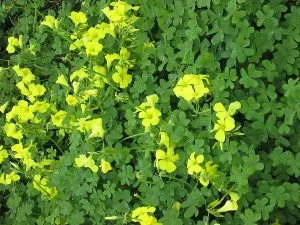Oxalis pes-caprae
OXALIDACEAE
Soursob, Bermuda buttercup, African Woodsorrell, Goatsfoot
A readily recognised familiar invasive weed in August. Native to South Africa introduced into SA in 1841.
Leaves are bright green, often with a single dark spot on each leaf, in a trifoliate (clover-like) arrangement grouped in a large clumping rosette on longish stalks to mid calf height. Bearing yellow flowers on longer stalks up to 150-350mm high, 5 free or slightly fused petals. Closing in the shade & at night. Flowering Winter to Spring.
Extremely difficult to eradicate, this weed propagates largely through its underground bulbils which easily break off when the weed is pulled up & spread , reinfesting the area. Up to 4500 kg/ha of bulbils can be produced in a year.
Repeated application of herbicide is the most effective control method on larger outbreaks, on smaller infestations in the garden one can try smothering/mulching the weed with newspapers or pieces of carpets. Do not pull up plants.
It is relatively harmless to humans & stock in small doses, fatal to guinea pigs & pet rabbits. In large doses it painfully fatal to stock. The sour tasting stalks are often enjoyed by children .It does contain Oxalic Acid. Has been used in folk medicine, as a food & dye.

